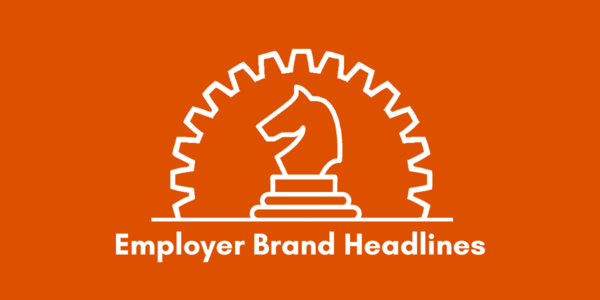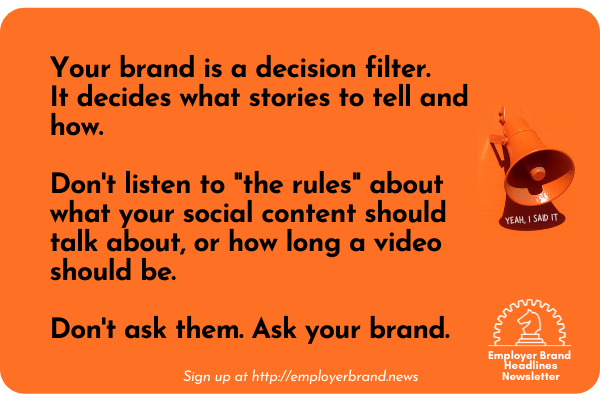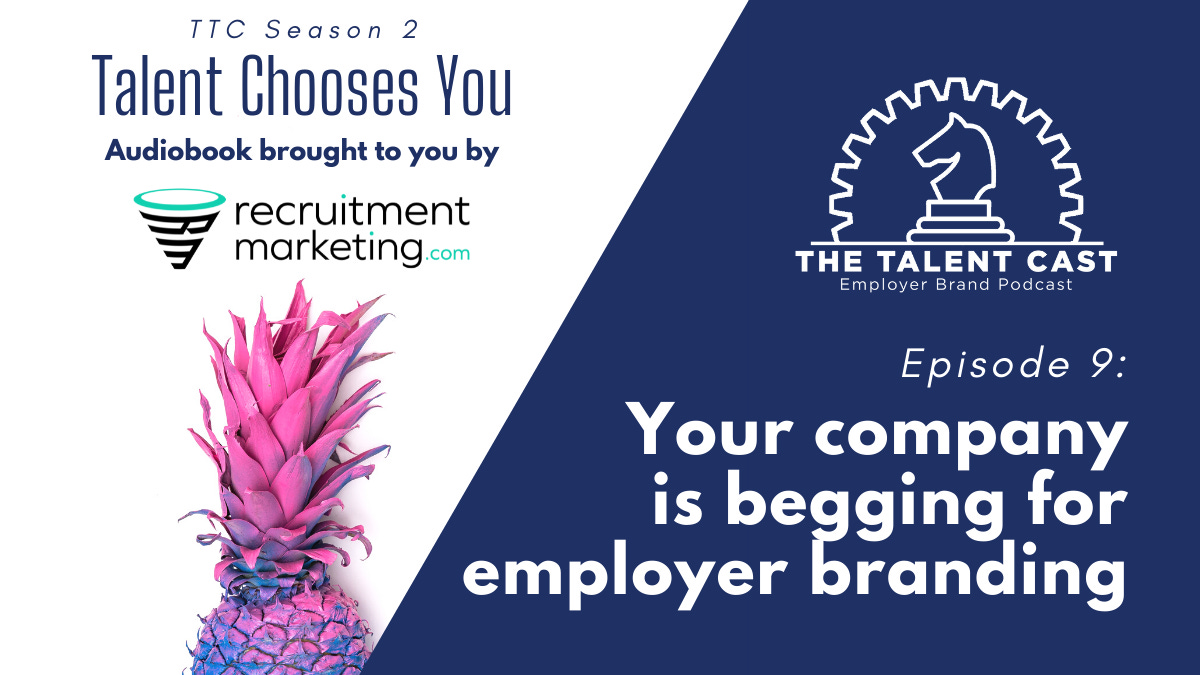♟️ Employer Brand Headlines #137: The "One Step Ahead" Edition ♟️
Your brand is a promise AND a filter. Use it.
Together, we can push the conversation around employer brand forward.
Employer Brand Headlines, is brought to you by James Ellis.
In this issue…
Your brand is a filter
Building useful personas
The secret to great metrics reports
The big idea
The last couple of weeks at the Day Job™ (hi, work folks!!!), I’ve been doing some foundational brand work. It’s been great, because so much of our roles are tactical: make that video, post that content, write that job post, design that graphic, edit that page on the career site, share those banners, etc. Leaving into the higher-level thinking is tough, but (so far) satisfying.
But it’s gotten me thinking about why brands matter. I mean, we all get that a brand is a promise made to consumers (of every stripe). But once that promise is made, how do we really use it the brand?
Some might assume that a brand is a design system: a set of phrases and visuals everyone is expected to use that (you hope) establishes and supports what you think your brand promise is all about. But that’s not it.
Some use a brand as a set of rules, a rigid set of guidelines of what you can and can’t say, predetermined and vetted by legal, comms, marketing and executive teams to create conformity and consistency. Yeah, no.
Let me ask the question a different way: On a given day, how are you using your brand?
Aside from being a promise, your brand is a decision-making filter. For example: you’re making a video, and you have infinite subjects and stories to tell. You have countless formats to leverage. You’ve got cameras and software and space to tell your story.
What story do you tell?
The brand determines it.
Your brand is how you make decisions on what stories to tell, who to highlight, and what the end product should look and feel like.
Your brand says the video should be an unscripted diverse group of people telling personal stories about work culture, recorded live with a few cameras to capture the moment because your brand promises inclusion. A scripted (vetted by a committee to ensure nothing could be taken out of context) talking-head video of the (old white male) leader talking about inclusion stitched together from four takes says you just like to talk about inclusion and undercuts your promise.
I’m tired of hearing rules about what content “should” be around content and tactics. They are always generalized best practices (code for: things you do when you don’t know what you’re doing) and don't actually know anything about my brand.
Should your video be short of long? Don’t ask Google, ask the brand (unless your brand is Google).
Should your video feel polished or rough? Don’t ask an “expert,” ask the brand.
Should your video be funny or serious? Hand-held on location or shot by a crew on a set? Stylized or realistic? Tik tok format or wideframe?
Ask the brand. It is there to help you make decisions. That’s literally what it’s there for.
Yep, we’re still podcasting about a book.
The revised and annotated audio version of Talent Chooses You (in 3D!) continues with episode 9, where I argue that despite appearances, your company is begging you to invest in employer branding.
Headlines!
Employer Value Proposition (EVP) and employer branding
The older I get, the more I realize that we’ve made the EVP some kind of convoluted and magical process. We talk about it like alchemy. It’s not. Do you know the value you offer someone who works there? Then that’s your EVP. That’s all it is. I mean… that’s ALL it is. [We Are Developers]
Turn Your Employer Brand Into a Growth Driver
Nice piece on seeing a brand in its totality: Employer brand is a core part of the company’s brand, not some second-class citizen. [Jonathon Palmer]
Seeing the Unseen: A New Lens on Visibility at Work
There are people at your company everyone sees (the loud-mouth gregarious-cheerleader types who probably show up a lot in your EB messages). Not only do those people want to feel seen, they tell other people outside your org that you care enough to see them. [MITSloan]
When Employer Branding Is One Big Waste of Time
If you’re unwilling to be different enough to stand out, why bother? [ERE]
To Win Over an Audience, Focus on Building Trust
Assume no one trusts what you or your recruiters have to say… at all. It makes for a better starting point. [HBR]
Organizations are rewarding employees for returning to work in person. Here’s how.
Work is a transaction: you get paid for doing something you wouldn’t normally do. Why isn’t going into an office something one should be compensated before (and no, crappy coffee and communal bathrooms do not count)? [Ragan]
Delivering effective recruitment marketing reports
According to this article, you should cram an insane amount of numbers and data around stuff that happened in the past, and then point out when numbers were good and when they weren’t. People who build reports like this NEVER get promoted. Why? Because no one actually cares what the numbers are. They only care about the insights from the numbers and what actions should be taken based on those insights. When you offer insights and forward-facing strategies (meaning “things to change to maximize impact”), you’re seen as a leader, someone who thinks like the business thinks. [Venn]
Candidate Personas: Your Competitive Advantage to Attracting Talent
My aversion to candidate personas is well-documented. But this is the first article in a while where I can say, “yeah, I get that,” mostly because it doesn’t rely exclusively on broad-based demographics. Sure, demographics matter, but in this piece, they are the first data point out of ten (!) on the list of things you need to know to make a useful persona. [Colette O’Neill]
Ten tips for writing better job ads
They seem simple, until you realize how rarely they are used. [Mitch Sullivan]
How to Make Your Organization’s Language More Inclusive
Why does it feel like every article on making language more inclusive could be re-titled “how to make your language less engaging” with no change to the text? Why aren’t we focusing on making the copy MORE engaging to different audiences instead of less attractive to anyone? [HBR]
Beware Of The False Promise Of Rebranding
A re-brand isn’t a new coat of paint or a cool new package. “Rebranding means to break with your existing brand promise and embrace a new (presumably more effective) brand promise.” [Brand Strategy Insider]
Inside the fortune cookie
“It’s not what you look at that matters. It’s what you see.” -Henry David Thoreau
Thanks, everyone!
Search the 1,300 links in the newsletter archive.
Read Talent Chooses You for free from this open source Google Doc
Like the music choices? Congrats, you’re old! Here’s the song archive as a Spotify playlist.
If you have a question, just reply to this email and it comes directly to me.
Cheers and thanks!
-James Ellis (LinkedIn | Twitter | Podcast | Articles)
Where the subject line came from:
One Step Ahead - Split Enz
Oh, how young Neil Finn is here! New Zealand’s gift to the musical world (Lorde needs to release another dozen albums to be in the running) in one of his earliest singles, which is also one of very first videos MTV ran. It’s such a weird pop tune: no chorus, lingering dread and just a flat-out goofy video. It’s still a great song.
If you are enjoying the music, I made a Spotify playlist of all the subject line songs I’ve used over the last year and a half:








